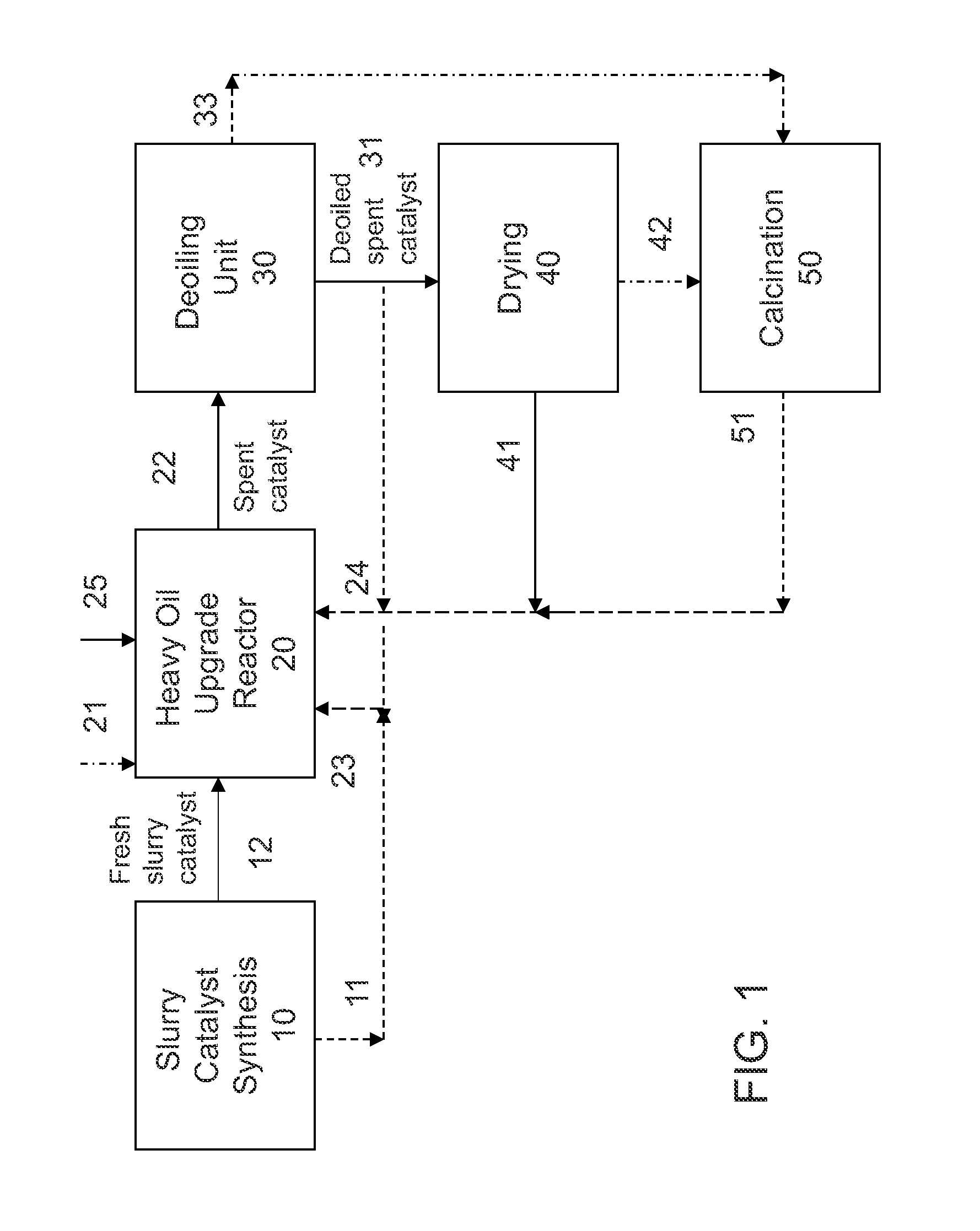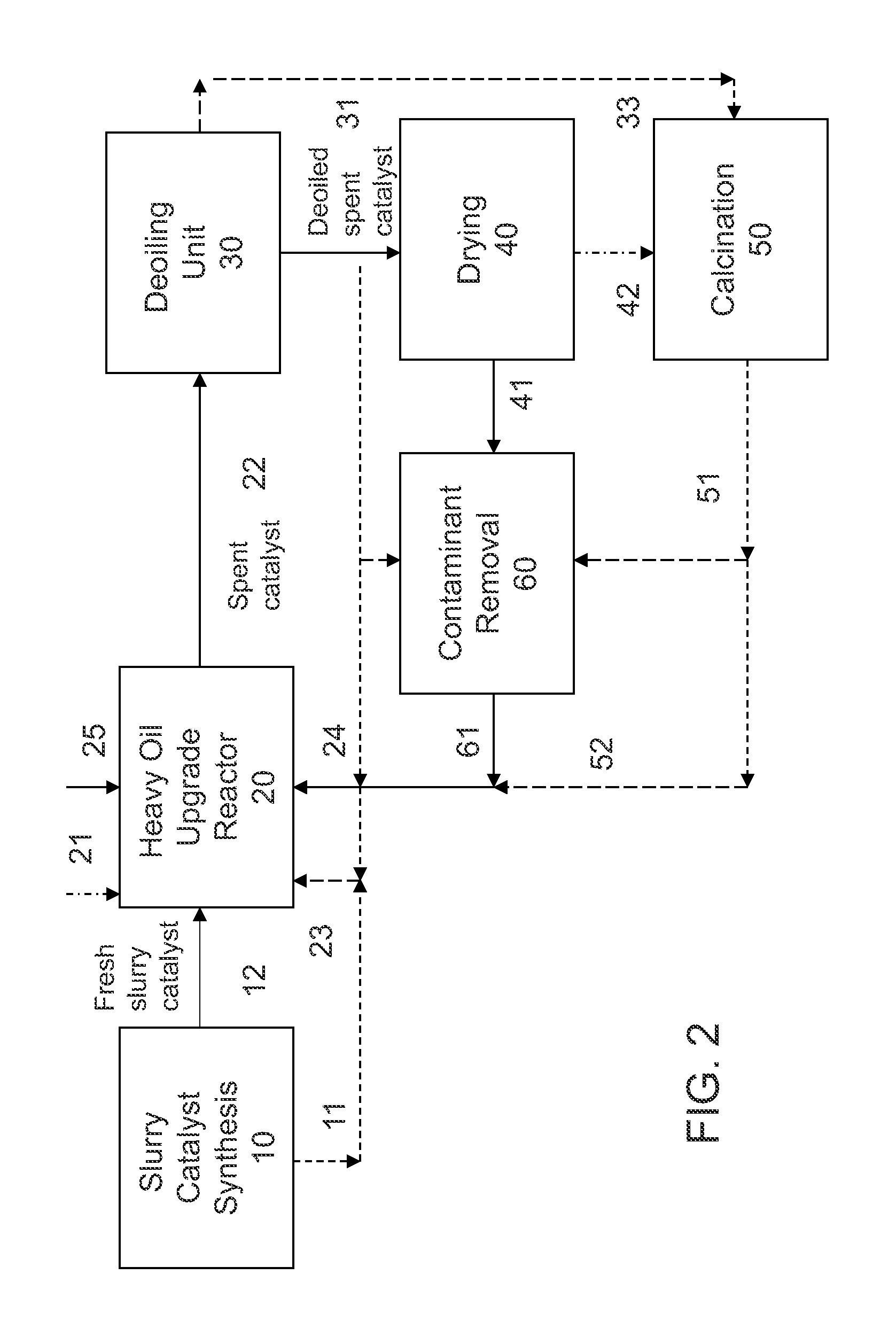Hydroprocessing catalysts and methods for making thereof
a technology of hydroprocessing catalysts and catalysts, applied in the field of catalysts, can solve the problems of increasing capital and operating costs, requiring a considerable amount of upgrading, and economic limitation as to the amount of catalysts that can be used, and achieve the effect of reducing metal deposits
- Summary
- Abstract
- Description
- Claims
- Application Information
AI Technical Summary
Benefits of technology
Problems solved by technology
Method used
Image
Examples
example 1
[0086]A Ni—Mo slurry catalyst as described in U.S. Pat. Nos. 7,737,072 and 7,737,073 was used in a heavy oil upgrade process as described in U.S. Pat. No. 7,390,398. The catalyst was used at a high concentration of Mo relatively to VR feed (4 wt. % Mo to VR), so it is “lightly-deactivated” with ˜50% of the original catalytic activity (relative to a fresh catalyst). The spent catalyst underwent a deoiling step similar to the procedures described in US Patent Publication No. 20100163499, employing a combination of sedimentation and a cross-filtration system wherein a solvent is added to the filtration feed stream, generating a deoiled solids coke product containing metal sulfides. The deoiled spent catalyst was slurried in VGO or VGO-based fresh slurry catalyst, at a VGO to deoiled spent catalyst weight ratio of 2:1 to 20:1, forming a slurried catalyst (“SCS” or spent catalyst slurry).
example 2
[0087]A second Ni—Mo deoiled spent catalyst was generated as in Example 1, except that the catalyst was employed at a low concentration of Mo relative to heavy oil feed (0.5 wt. % Mo to VR), retaining less than ˜⅓ of the original catalytic activity. Table 1 summarizes the properties and characteristics of the deoiled spent catalyst samples. The deoiled spent catalyst was slurried in VGO or VGO-based fresh slurry catalyst, at a VGO to deoiled spent catalyst weight ratio of 2:1 to 20:1, forming a slurried catalyst (“SCS” or spent catalyst slurry).
TABLE 1Example 1Example 2CompositionMo, wt %39.2730.37Ni, wt %4.053.56V, wt %0.662.91C, wt %23.3534.28PorosimetrySA, m2 / g33.119.14TPV, cc / g0.1370.065PV (>100 Å), cc / g0.1090.062Particle Size DistributionMean Dp (volume-basis, sonic), μm8.229.0Mean Dp (number-basis, sonic), μm0.270.72
example 3
[0088]A third Ni—Mo deoiled spent catalyst was generated as in Example 1, an analysis of the spent catalyst solid shows 24.91 wt. % Mo, 4.42 wt. % Ni, and 6.22 wt. % V (primarily oxide form).
PUM
 Login to View More
Login to View More Abstract
Description
Claims
Application Information
 Login to View More
Login to View More - R&D
- Intellectual Property
- Life Sciences
- Materials
- Tech Scout
- Unparalleled Data Quality
- Higher Quality Content
- 60% Fewer Hallucinations
Browse by: Latest US Patents, China's latest patents, Technical Efficacy Thesaurus, Application Domain, Technology Topic, Popular Technical Reports.
© 2025 PatSnap. All rights reserved.Legal|Privacy policy|Modern Slavery Act Transparency Statement|Sitemap|About US| Contact US: help@patsnap.com


